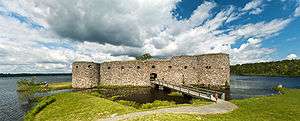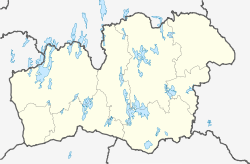Växjö
| Växjö | ||
|---|---|---|
 Ruins of Kronoberg Castle, Växjö | ||
| ||
 Växjö  Växjö | ||
| Coordinates: 56°52′37″N 14°48′33″E / 56.87694°N 14.80917°ECoordinates: 56°52′37″N 14°48′33″E / 56.87694°N 14.80917°E | ||
| Country |
| |
| Province | Småland | |
| County | Kronoberg County | |
| Municipality | Växjö Municipality | |
| Area[1] | ||
| • City | 30.28 km2 (11.69 sq mi) | |
| Elevation | 167 m (548 ft) | |
| Population (5 September 2017)[1] | ||
| • City | 66,275 | |
| • Density | 2,011/km2 (5,210/sq mi) | |
| • Metro | 90,721 | |
| Time zone | UTC+1 (CET) | |
| • Summer (DST) | UTC+2 (CEST) | |
| Postal code | 35x xx | |
| Area code(s) | (+46) 47 | |
| Website |
www | |
Växjö (Swedish pronunciation: [²vɛkːɧøː]) is a city and the seat of Växjö Municipality, Kronoberg County, Sweden. It had 66,275 inhabitants (2016) out of a municipal population of 90,721 (2017). It is the administrative, cultural, and industrial centre of Kronoberg County and the episcopal see of the Diocese of Växjö. The town is home to Linnaeus University.
Etymology
The city's name is believed to be constructed from the words "väg" (road) and "sjö" (lake), meaning the road over the frozen Växjö Lake that farmers used in the winter to get to the marketplace which later became the city.
History
In contrast to what was believed a century ago,[2] there is no evidence of a special pre-Christian significance of the site. The pagan cultic center of Värend may have been located at Hov, a nearby village.[3][4]
An episcopal see since the 12th century, the city did not get its city charter until 1342, when it was issued by Magnus Eriksson. The cathedral of St Sigfrid dates from about 1300, and has been subsequently restored.[5] Otherwise, during the Middle Ages, Växjö did not have many pious institutions. A Franciscan monastery was established in 1485. A hospital of the Holy Ghost was first mentioned in 1318. In the 14th century Växjö got its first school, Växjö katedralskola. In 1643 it received gymnasium status.
At the beginning of Gustav Eriksson's war of liberation, the peasantry joined forces, under the guidance of the union-hostile bishop Ingemar Pedersson, with the mountain men and peasantry of Dalarna, Hälsingland, and Gästrikland, who urged fidelity to their leader Gustav Eriksson. During the Dacke War, a peasant uprising, the city was under the authority of Nils Dacke and his supporters from the summer of 1542 until after New Year 1543.
Several times during the Northern Wars and the Scanian Wars, and thereafter, the city was affected by fire (in 1277, 1516, 1570, 1612, 1658, 1690, 1749, 1753, 1799, 1838 and 1843). After the last fire in 1843, when 1,140 citizens were rendered homeless, Växjö received its current street plan.[6]
The Barbarella nightclub was prominent in southeastern Sweden in the 1970s, attracting several major international bands. Växjö is the city in which the "Kvinnan med handväskan" photograph was taken in 1985 by Hans Runesson.
In its December 2015 report, Police in Sweden placed the Växjö district Araby in the most severe category of urban areas with high crime rates.[7]
2015 Växjö arsons
In 2015, there were a series of four arson incidents tied together via the location in which they occurred.
On February 24, 2015, a fire broke out in a barber shop at Dalbo, Växjö. A 17-year-old girl was later apprehended. On June 18, 2015, the suspect was sentenced to institutional juvenile detention brought upon by charges of first-degree arson. The motive of the crime remains unknown but is thought to be revenge.
The target features an 11-time attempted attack on an ice cream van located near Kampa Pelare, Växjö.[8] The van's interior was left burned out while its exteriors remained relatively intact. No suspects have been identified.[8]
On June 24, 2015, a fire occurred in a wooden shack and a barn in Attsjö.[9]
In May 2015, two boys were found guilty of second-degree arson; setting fire to a kindergarten.[10] One of the boys was given an institutional juvenile detention while the other one's whereabouts remains unknown.[11]
Demography
| Historical population | |||||||||||||||||||||||||||||||||||||||||||
|---|---|---|---|---|---|---|---|---|---|---|---|---|---|---|---|---|---|---|---|---|---|---|---|---|---|---|---|---|---|---|---|---|---|---|---|---|---|---|---|---|---|---|---|
|
| ||||||||||||||||||||||||||||||||||||||||||
| Source: [12] | |||||||||||||||||||||||||||||||||||||||||||
Population numbers by city districts
- Teleborg: 12,834
- Hovshaga: 9,541
- Hov: 8,020
- Araby: 6,520
- Norr: 4,518
- Väster: 4,829
- Öster: 4,489
- Söder: 3,694
- Sandsbro: 3,090
- Högstorp: 2,710
- Öjaby: 2,213
- Centrum: 2,086
- Räppe: 1,260
- Kronoberg/Evedal: 279
- Regementstaden: 88
- Västra mark: 69
- Norremark: 29
Communications
The Coast to Coast track cuts through the municipality from north-west to south-east. SJ´s long-distance trains travel between Gothenburg, Alvesta (with connections to the southern trunk line) and Kalmar, with stop in Växjö. Öresundståg´s long-distance trains travel the Kalmar – Alvesta – Malmö route. Regional trains Krösatågen travel the Växjö – Jönköping route. Trunk roads 23, 25, 27, 29, 30 and 37 meet in the municipality.
Environmental policy
In 1996 the city adopted a policy for the elimination of the use of fossil fuels by 2030.[13][14] This decision was taken in reaction to pollution and eutrophication in the lakes that surround the town. Greenhouse gas emissions were cut by 41% from 1993 to 2011, and were reduced by 55% by 2015. The city's economy has grown during this time.[15]
By 2014, Växjö's CO2 emissions had dropped to 2.4 tonnes per capita, well below the EU average of 7.3 tonnes.[16]
The Greenest City in Europe
Växjö has called itself "The Greenest City in Europe" since 2007.[17] It has its foundation in a long history of commitment to environmental issues, and ambitious goals for a green future. It is a vision shared with the citizens and the local companies.
In 2017 Växjö was awarded the European Green Leaf Award 2018 by the European Commission. The prize is awarded to cities with less than 100 000 inhabitants that show good results and ambitions in terms of environment and committed to generate green growth.
Notable locations
The city has three municipality-run secondary schools ("gymnasiums"): Teknikum, Katedralskolan, Växjö, and Kungsmadskolan. Linnaeus University had a student body of 42,000 students as of 2012.[18]
Industries include GE Power and Aerotech Telub, as well as Volvo Articulated Haulers which is located in Braås 29 kilometres (18 miles), north of Växjö. One of the best-known service providers is Visma. Växjö houses Sweden's National Glass Museum [19] and claims to be the capital of the "Kingdom of Crystal" [20] as well as of the "Kingdom of Furniture".[21]
The Swedish Emigrant Institute [22] was established in 1965 and is housed in the House of Emigrants near Växjö Lake in the heart of the city. It contains archives, a library, a museum, and a research center relating to the emigration period between 1846 and 1930, when 1.3 million (or 20%) of the Swedish population emigrated, mainly to the United States. Archives dating to the 17th century contain birth and death records, as well as household records, that are available on microfiche.
Immediately north of Växjö is Kronoberg Castle, a ruined fortress constructed in the 15th century. This castle was used as a base by the rebel, Nils Dacke, during the Dacke War. The fortress has thick walls and artillery portals that face north towards lake Helgasjön. Teleborg Castle is also located near the city. It was built near the Linnaeus University in the year 1900 as a morning (wedding) gift. Teleborg Castle now functions as a hotel and conference facility.
Since 2016, Fortnox Arena has held a video game speedrunning event in July. The event aims to raise money for the Save the Children charitable foundation. Over 400 attendees are expected to turn up for ESA 2017.[23]
Climate
Växjö has a humid continental climate (Dfb), using temperature data from 1961-1990. Temperatures have risen in recent years, and using the -3 Celsius isotherm, it can also be classified as an oceanic climate (Cfb)[24] with 2002-2015 temperature data. It is milder, wetter, and cloudier than the rest of the country, with the number of hours of sunshine being associated more with the British Isles than with areas further north in Sweden. Considering its relative distance to all three coasts surrounding South Sweden, the climate is markedly marine, with winter temperatures being relatively low for an inland location. When compared with sunnier inland areas further north, Växjo has relatively cool summers.
| Climate data for Växjö | |||||||||||||
|---|---|---|---|---|---|---|---|---|---|---|---|---|---|
| Month | Jan | Feb | Mar | Apr | May | Jun | Jul | Aug | Sep | Oct | Nov | Dec | Year |
| Record high °C (°F) | 9.6 (49.3) |
13.8 (56.8) |
20.0 (68) |
27.9 (82.2) |
29.0 (84.2) |
32.5 (90.5) |
33.5 (92.3) |
34.4 (93.9) |
27.6 (81.7) |
21.9 (71.4) |
14.0 (57.2) |
11.3 (52.3) |
34.4 (93.9) |
| Average high °C (°F) | 0.4 (32.7) |
1.0 (33.8) |
5.5 (41.9) |
12.0 (53.6) |
16.4 (61.5) |
19.6 (67.3) |
22.2 (72) |
21.0 (69.8) |
16.8 (62.2) |
10.3 (50.5) |
5.6 (42.1) |
2.0 (35.6) |
11.0 (51.8) |
| Daily mean °C (°F) | −1.6 (29.1) |
−1.4 (29.5) |
1.6 (34.9) |
6.7 (44.1) |
11.2 (52.2) |
14.4 (57.9) |
17.3 (63.1) |
16.4 (61.5) |
12.6 (54.7) |
7.2 (45) |
3.5 (38.3) |
0.0 (32) |
7.3 (45.1) |
| Average low °C (°F) | −3.7 (25.3) |
−3.9 (25) |
−2.3 (27.9) |
1.4 (34.5) |
6.0 (42.8) |
9.2 (48.6) |
12.4 (54.3) |
11.8 (53.2) |
8.4 (47.1) |
4.1 (39.4) |
1.4 (34.5) |
−2.0 (28.4) |
3.5 (38.3) |
| Record low °C (°F) | −34.0 (−29.2) |
−28.8 (−19.8) |
−29.8 (−21.6) |
−19.0 (−2.2) |
−6.0 (21.2) |
−0.8 (30.6) |
3.5 (38.3) |
0.0 (32) |
−4.8 (23.4) |
−10.3 (13.5) |
−17.8 (0) |
−24.5 (−12.1) |
−34.0 (−29.2) |
| Average precipitation mm (inches) | 52.1 (2.051) |
34.9 (1.374) |
41.4 (1.63) |
39.6 (1.559) |
47.6 (1.874) |
54.9 (2.161) |
76.6 (3.016) |
57.4 (2.26) |
71.0 (2.795) |
57.8 (2.276) |
63.4 (2.496) |
55.6 (2.189) |
652.6 (25.693) |
| Mean monthly sunshine hours | 34 | 63 | 100 | 151 | 214 | 218 | 202 | 193 | 125 | 72 | 45 | 23 | 1,440 |
| Source #1: SMHI[25] | |||||||||||||
| Source #2: SMHI Monthly Data 2002–2015[26] | |||||||||||||
Notable people
- Joachim Björklund, footballer[27]
- Jonas Björkman, tennis player with 50 doubles titles including Grand Slams
- Karl-Birger Blomdahl, 20th-century music composer[28]
- Maria Cederschiöld (deaconess)
- Danuta Danielsson, 1947–1988
- Bjorn Englen, bass player of Yngwie Malmsteen's Rising Force
- Knute Heldner, 20th-century Swedish American artist
- Stefan Johansson, Formula 1 racing driver
- Jonas Jonasson, writer[29]
- Owe Jonsson, track and field athlete and European champion
- Martin Kellerman, comic strip creator
- Carolina Klüft, track and field athlete and Olympic gold medalist at Athens 2004
- Pär Lagerkvist, author and winner of the Nobel Prize in Literature, 1951
- Otto Lindblad, 19th-century music composer
- Carl Linnaeus, botanist, physician and zoologist
- Melody Club, rock band[30]
- Christina Nilsson, 19th-century soprano celebrity
- Andreas Ravelli, footballer
- Thomas Ravelli, football goalkeeper
- Sophie Sager, 19th-century writer and feminist
- Peder Sjögren, 20th-century author and playwright
- Jonas Swensson, President of the Augustana Evangelical Lutheran Church
- Håkan Syrén, a military General and Supreme Commander of the Swedish Armed Forces[31]
- Esaias Tegnér, poet and bishop of Växjö
- Mats Wilander, tennis player with seven Grand Slam victories 1982–1988
- Björn Wirdheim, racing driver[32]
- The Ark, rock band
Sports clubs
The following sports clubs are located in Växjö:
- Östers IF – football
- Hovshaga AIF – football, floorball, and tennis
- Växjö BK – football
- Växjö Lakers – ice hockey
- Växjö Vipers – floorball
- Wexjö RK – rugby
- Växjö OK – orienteering
- Växjö DFF – football
- Växjö United FC - football
References
- 1 2 "Tätorternas landareal, folkmängd och invånare per km2 2005 och 2010" (in Swedish). Statistics Sweden. 14 December 2011. Archived from the original on 10 January 2012. Retrieved 10 January 2012.
- ↑ "Växjö". Nordisk Familjebok. 1922.
- ↑ Lars-Olof Larson (1999). "Land och län under kristendomen millennium". Landen kring sjöarna. p. 69. ISBN 91-86870-10-6.
- ↑ Martin Hanson (2007). Det medeltida Småland – en arkeologisk guidebok. p. 137. ISBN 978-91-85377-93-0.
- ↑

- ↑ "459-460 (Nordisk familjebok / Uggleupplagan. 33. Väderlek – Äänekoski)". Runeberg.org. Retrieved 1 December 2012.
- ↑ Utsatta områden - sociala risker, kollektiv förmåga och oönskade händelser (PDF). Police in Sweden - Nationella Operativa Avdelningen - December 2015. p. 29. Archived from the original (PDF) on 19 August 2016.
- 1 2 "Brand i glasskiosk vid Växjösjön". Sveriges Radio. 17 September 2015. Retrieved 27 June 2017.
- ↑ "Ladugård brann ner". Sveriges Radio. 25 June 2015. Retrieved 27 June 2017.
- ↑ "Ny brand i Växjö under måndagskvällen". Sveriges Radio. 12 May 2015. Retrieved 27 June 2017.
- ↑ "Mordbrandsmisstänkt 16-åring tidigare dömd för anlagda bränder". Smålandsposten. 14 June 2016. Retrieved 27 June 2017.
- ↑ "Växjö inhabitants (2013)". www.vaxjo.se. Retrieved 1 December 2013.
- ↑ "The Swedish city touted as 'Europe's greenest'". The Local. 24 January 2014. Retrieved 15 October 2015.
- ↑ "The European cities moving faster on clean energy than their governments". The Guardian. 6 July 2015. Retrieved 15 October 2015.
- ↑ "Zero Net Emissions With Economic Growth? Europe's Greenest City Shows the Way". CSRwire. 6 July 2011. Retrieved 15 October 2015.
- ↑ "7 examples of sustainability in Sweden 2017 Växjö got the Green Leaf Award 2018 from EU-commission". Swedish Institute. 24 September 2015. Retrieved 15 October 2015.
- ↑ Slavin, Terry (25 November 2015). "What can the world learn from Växjö, Europe's self-styled greenest city?". Rockefeller Foundation via The Guardian. Guardian Media Group. Retrieved 28 July 2018.
- ↑ "Färre studenter till 2015" (PDF). kalmar.se. Kalmar municipality. Archived from the original (PDF) on 19 November 2016. Retrieved 19 November 2016.
- ↑ Archived 3 April 2009 at the Wayback Machine.
- ↑ Archived 23 October 2005 at the Wayback Machine.
- ↑ "Lammhult". Lammhult.se. Retrieved 1 December 2012.
- ↑ Archived 26 August 2005 at the Wayback Machine.
- ↑ "European Speedrunner Assembly". European Speedrunner Assembly. Retrieved 18 February 2017.
- ↑ "Vaxjo, Sweden Climate Summary". Weatherbase. Retrieved 3 April 2015.
- ↑ "Precipitation Normals 1961–1990" (in Swedish). Swedish Metereological and Hydrological Institute (Växjö code 6452).
- ↑ "Yearly and Monthly Statistics". SMHI. 16 July 2016.
- ↑ "Dette er svensken som gjorde det Norling aldri klarte". Retrieved 22 February 2017.
- ↑ "Karl-Birger Blomdahl". AllMusic. Retrieved 24 February 2017.
- ↑ "Jonas Jonasson: My 100-year-old hero, and the secret of happiness". The Telegraph. Retrieved 22 February 2017.
- ↑ "Melody Club". AllMusic. Retrieved 22 February 2017.
- ↑ "Spionchefen Håkan Syrén blir ny ÖB". Retrieved 24 February 2017.
- ↑ "Motor Racing : Celebration costs driver victory on finish line". The New York Times. Retrieved February 22, 2017.
External links
| Wikimedia Commons has media related to Växjö. |
- Växjö Municipality – Official site
- Växjö tourist information in english
- (in Swedish)Växjö article in Nordisk familjebok


